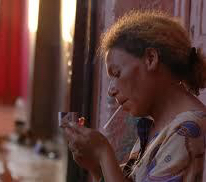February 6, 2023
Alexandra Kinias

At Night, They Dance (Documentary, Canada)
Directors: Isabelle Lavigne, Stephane Thibault
Sales: Autlook Filmsales, Vienna
Production: Les Films du Tricycle
Producer: Lucie Lambert,
Director of photography: Stephane Thibault
Music: Benoit Charest
Editor: Rene Roberge
No rating: 80 minutes
Release Date: 2011

At Night, They Dance, exposes a slice of the Egyptian society that lives and works in its shadows. The title successfully depicts the essence of the documentary. The belly dancing dynasty, which the documentary brings its story to life, revolves around the profession that its members performed at night. Reda, the 42 years old matriarch mother of seven, once a bellydancer herself, was widowed five months prior to filming the documentary. After she retired from the business, she passed the torch to three of her daughters, and acts now as their manager.
The documentary is culturally shocking and emotionally painful. What makes it intriguing, though, it discloses a taboo in the Egyptian conservative society, never captured before. Reda’s daughters dance in revealing costumes. With gold bracelets jingling around their wrists and cigarettes burning between their lips, they mingle openly with men. A girl returning home at the crack of dawn seems totally acceptable, or so it is portrayed.
The unscripted film floats between a documentary and a reality television show. With its loose structure and no narration, viewers are introduced to the characters and their stories from their conversations among themselves and with the people around them. Reda and her brood live in a narrow apartment located in a heavily populated Cairo slum, a place where residents are protected from the eyes of the outside society and the law enforcement. Through the limited space, the camera wanders between two rooms scarce of furniture, yet crowded with their inhabitants and guests. Not paying much attention to the camera filming them, the women openly talk about their lives and problems. Their words are expressed in vocabulary rarely used in Egyptian cinema.Reda on her cellphone

While sitting on a plastic rug, Reda conducts business on her cellphone, surrounded by her family and her five years old son who parades around the house stark naked, in every scene filmed indoors. The mother of this controversial brood, who is also a divorcee, spends a great deal of her time attacking or defending her daughters. The documentary doesn’t give any explanation about their past lives and nothing is exposed about their present that has no direct relation to their profession. Amira, the eldest daughter doesn’t show up to work because sometimes she is stoned. After she lost custody of her child to her ex-husband, Amira found comfort in drugs. Bossy, is a sweetheart, but a lazy girl who often misses work even after she gets paid. Hind, the fifteen years old is having a relationship with a married man whose protection she seeks when she is out late at night.Bossy getting ready for work

The documentary takes place between the walls of their house and the street where they dance. According to the documentary, they dance in weddings, but the settings looked more like an open air nightclub where men sat around tables set between buildings and watched the show. Reda and her daughters are essential components in an industry that depends heavily on them. Costume designers and rentals, hair dressers, agents and musicians, all depend on Reda’s clan.
The faint traces of another life’s beauty are evident in Reda’s face, already withered beyond her years. Driven by poverty, she is trapped in a cycle where she has to keep going for the sake of her family. The message portrayed in the documentary overshadows any flows in its production. Everything is dwarfed next to the powerful stories of the women’s survival. There are no men in their lives they can depend on. The single phone call not related to a job was to Hind’s father, Reda’s ex-husband. She asks him to bail Hind who was busted on her way back at night, but he declines to do so.

At Night, They Dance, raises a lot of questions and leaves the viewer curious to learn more about these women, the interesting paradox about their profession and their place in society. Growing up in a culture where women are viewed to be the reason for men’s sins and thus must be covered up, these girls dance to men in revealing costumes that show more than they cover. These contradictions confuse them and fill them with guilt about their gender and their whole existence, believing they are source of men’s temptations.

The documentary gives us a glimpse of their lives, without probing into their past or future and what they want out of life. They live from day to day with no vision for their future. They accept their situation and circumstances, complain nor question their existence, yet there is sadness in their eyes. It was sad to see how they never smiled, not even when dancing on stage, which makes one wonder if they are even aware that another life exists outside their cheap costumes, heavy make-up and wigs.
To watch At Night, They Dance trailer click here.
***If you liked this article, don’t forget to subscribe to our newsletter and receive our articles by email.

I very much want to watch this documentary, but when I click to see it I get this message, “this video is private”. I subscribe to Women of Egypt and I live in Canada….
Thank you.
LikeLike